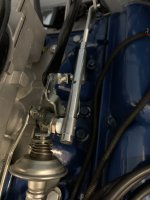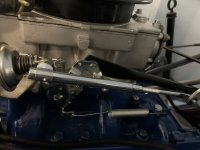Wow...........I'm confused!
First, that carb did not come on a "K" code 271 HP originally (or it's been modified by changing the throttle shaft to a kick down style). No "K" codes ever had C4's originally that I have seen. All were either T-10's or Top Loader four speeds. Back in the day I owned a 64 Fairlane Sports Coupe that was an original "K" code car, but it was purchased originally by a DR. and he had it converted to a C4 with all original factory parts. This was my daily driver in the late 60's. It looked 100% original except they left the clutch pedal assembly in it. So, the 4100 carb likely came from another FE motored car with an automatic that used the mechanical kick down rod. The 4100's were used until the late 60's, when we started to see most of the low performance V8 motors come with 4300 Autolites.
How do you know the secondaries do not open? Why do you suspect a vacuum problem? What does the carb's vacuum operated secondaries have to do with the transmission kick down rod? Yes, it had a very light tension spring that connected to the hole at the top of the hole just in front of your kick down rod. The dash pot (anti stall) mounting bracket had a small hole right near the carb mounting stud, as I remember. As long as the kick down rod returns, it will work fine just the way you have it. Just have someone sit in the vehicle. Push the throttle down fully to the floormat and make certain the carb linkage is adjusted to give you full throttle at the throttle plates. Then before they let up, take your thumb and see if the kick down rod is actually manually down shifting the transmission valve body. It's possible, especially when assembling a system from various parts sources, to have the kick down rod prevent the carb from reaching full "open throttle", so it's a good thing to check and takes only a minute.
IMO, it's very doubtful you actually need the accelerator fuel pump rod in the top adjustment hole. The second hole is fine and gives enough fuel shot even in cold weather.
You don't show any pictures of the right side of the carb. Is it a manual choke or automatic choke? If automatic, how is it heated? Have you installed a closed loop heat tube for the choke? You don't want the carb sucking dirt into your new engine.
You will never be able to see the vacuum secondaries open unless you could load the engine, and also get it to turn enough RPM on a dyno. If everything is adjusted correctly to stock settings, that 4100 carb is going to work great on your engine. You can play with different tension and length secondary springs, but the stock setup worked very well and never gave a problem.
I would disconnect your transmission kick down rod. Next disconnect the throttle linkage. Just leave the throttle return spring attached. Start the engine, let it fully warm up. Make certain you do not have any of the fast idle choke linkage holding the throttle open. This linkage is on the right (passenger side) of the carb. You should be able to get it to adjust to run at 700-800 RPM and have the idle mixture screws be sensative to adjustment. If the initial timing is over 10-12 degrees, it's not going to have a normal idle. You want only "ported vacuum" run to the vacuum advance distributor, not manifold vacuum.
I worked as a tune-up tech at a large volume Arizona Ford Dealership '65-'71 and have rebuilt hundreds of Autolite 2100/4100 series carbs.
John
















